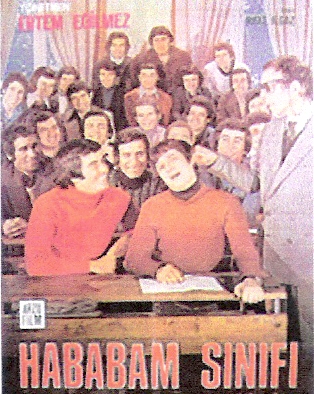Yeşilçam, which translates to “Green Pine”, is a shorthand for Turkey’s old film industry. The name comes from Yeşilçam Street, an area of Beyoğlu that served as the epicenter of Turkish popular cinema in the 1970s, the golden age of Yeşilçam. During this decade, the film industry was producing an unbelievable number of films – around 300 a year. But with the rise in popularity of televisions came the decline of Yeşilçam, a name that now seems like a time capsule, evoking a very distinctive, yet dated, era.

Why do I love Yeşilçam films? My sisters and I once came across my father’s scrapbook from the ’60s and ’70s, when he was an adolescent, and it was full of beautiful actresses that he admired; it looked so retro and magical. Around the same time we started watching the films on video. I instantly bonded with Turkish culture, despite growing up in England, and for that I have Yeşilçam to thank.
For other Yabangees too, the films provide an insight into the Turkish psyche and culture during this time period. They depict the average Turkish man and woman in the 1970s very well; someone who tries to stay out of trouble, get married, start a family and live in relative material comfort. But there are always obstacles presented by stereotypical scenarios. Evil and exploitative rich people try to corrupt naïve and good-natured poor people. Gender roles are rigid, with men who are macho and women who are beautiful and helpless; as a result, there are a lot of honour-related themes. Minorities and villagers are simple-minded, often their accents in themselves being the joke, but they persevere and succeed in the end. In addition to this is the cheap and cheerful style of film-making that includes dubbing all the female, male and children’s voices by the same few voice actors, a move that feels kitsch and rose-tinted. It is perfect escapism for the masses.
The industry has produced stars such as Türkan Şoray, Kadir İnanır, Tarık Akan, as well as Cüneyt Arkın, who has become a bit of a laughing stock in Turkish popular culture for uttering the nonsensical phrase ‘nayır nolamaz!’ which is Cüneyit-talk for ‘hayır olamaz!’ (trans: No, it’s impossible!).
So without further ado, here are my top 5 Yeşilçam films:
1. Hababam Sınıfı (The Chaotic Class, 1974-1981)
Technically this isn’t a single film, it is a series of comedy films about the lives and antics of a class of rowdy teenagers, played by grown men, among whom is the well-known character of İnek Şaban (Şaban the Geek) played by much-loved actor Kemal Sunal. Another great actor in the series is Şener Şen who plays the Adidas tracksuit-clad gym teacher who barks orders like Hitler in a Charlie Chaplin-esque way that is side-splittingly funny. A staple in Turkish comedy, these films are well worth watching.
2. Davaro (1981)
Once again, Kemal Sunal and Şener Şen of Hababam Sınıfı fame team up like Tweedle Dee and Tweedle Dum to play two enemies in this 1980s comedy. Sunal’s character Memo comes back from Germany, having made his fortune, to marry his betrothed Cano, only to be told by his family to kill an old enemy, Sülo (Şen) or else forget about getting married. In a bid to not kill Sülo, the two work out a plan to pretend to kill and bury him. But the breathing pipe in the coffin reaches Sülo’s arse instead of his mouth The problems don’t end there as the men face further threats that bond them like brothers to the point that one of them smuggles the other out of prison by donning a black burka! Highly entertaining and lighthearted.
3. Yol (The Road, 1982)
This isn’t a typical Yeşilçam film in that it is more arthouse and realistically depicts the human condition in Turkey in a more serious manner. Yol is a film by Yılmaz Güney, who directed it while in prison by sending instructions to his assistant director. After Güney escaped from prison, he took the negatives of the film to Switzerland and later edited it in Paris. It won the 1982 Fipresci Prize at the Cannes Film Festival. Despite its critical success abroad, it has caused much controversy in Turkey, and was banned until 1999 due to Güney’s notoriety. Yol follows the lives of prisoners who have been given a week’s home leave in the aftermath of the 1980 Turkish military coup. The three main characters in the film live in a world of imprisonment both in their inner and outer lives. Seyit is given the difficult task of killing his wife in an honour killing. Mehmet and his wife decide to run away and are persecuted by family and strangers alike. Ömer attempts to cross the border to escape prison only to make things worse for himself. The lives of these prisoners isn’t just constrained by their imprisonment, tradition also threatens their freedom. Why watch it? Because it’s a masterpiece in Turkish cinema.
4. Dila Hanım (1977)
This film stars two of Yeşilçam’s most beautiful stars, Türkan Şoray and Kadir İnanır. Dila Hanım (Şoray) is the grieving widow of a recently deceased Ağa (feudal landowner) who is hell-bent on wreaking revenge on Rıza Bey (İnanır), the man who murdered her husband. She sends her men to kill him and then ironically, saves his life because she doesn’t know it’s him. He pretends to be a humble miller when in fact he’s a well-groomed and moustachioed playboy-type who spends more time in the gazinos of Istanbul than in his ancestral land. Throughout the film there is an atmosphere of suspense and the sense that the two characters are committing sin. This, mixed with the cheesy music and the lingering glances that the two give each other suggest that reality is a wonderful fairy tale for the two. But will it last? Watch out for the Zeybek dance, it’s so romantic!
5. Selvi Boylum Al Yazmalım (The Girl With the Red Scarf, 1978)
This is another romantic film that stars Türkan Şoray and Kadir İnanır. It is directed by Atıf Yılmaz and is based on the short story “The Red Scarf” by Chinghiz Aitmatov, about a village girl who falls in love with a truck driver from Istanbul. It’s the story of a love fulfilled immediately but with a twist. İlyas (İnanır) and Asya (Şoray) fall in love, get married and have a child. But do they live happily ever after? Or does he cheat on her and she runs away from him with their child and finds refuge in the arms of a reliable, but less attractive, man? See how I revealed some of the plot there? In the end, Asya must decide whether to get back together with İlyas after all these years when he’s learnt the error of his ways and feels deep regret, or whether to stay with the man who has given them a roof over their heads and devoted his life to Asya and her child. I guess you’ll have to watch to find out!
What are you favourite Yeşilçam films? Tell us in the comments!
Images intended as fair use.











Reading this review sure has persuaded me to watch a few of these movies! 😉
That’s great to hear, Myra! They’re all great films to watch!
you also need to watch “Ah Nerede” with Tarık Akan and Gülşen Bubikoğlu. Masterpiece!
[…] the success of Yeşilçam in the 1970s, Turkey went through two decades of political and financial instability in which the […]
[…] The past years have seen a renewing interest among urban youth for the nostalgic times of the gazino and variety shows golden age that are often featured in the movies of Turkish cinema golden age, known as the Yeşilçam era. […]